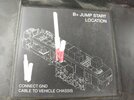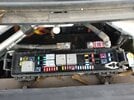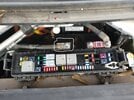info:
2015 Model S 70
175K miles
new 12v battery installed at service center 5 months ago
I was supercharging two days ago (in a rainstorm). At 47%, it suddenly stopped charging. An alert said low voltage. Soon after that an alert said unable to drive. I had a friend pick me up and take me home (I live nearby).
Yesterday, I went to the car and discovered that the 12v battery was so low, the handles did not extend. It barely had enough to open the trunk. So, I knew that if I could jumpstart it, maybe I would be able to drive it. I still think that something is wrong to cause the battery to drain, but driving it to the service center (128 miles away) beats the $600 cost to have it towed there.
Online videos showed me how to remove the nose cone and there should be two bolts there to attach the jumper cables. Unfortunately, when I removed my nose cone, there was just one bolt. So, I opened the frunk and removed the center cover and the fusebox cover to reveal two terminals to which I could jump.
The fusebox cover diagram indicated that the passenger side terminal was the positive (see picture). I had a fully charged portable jumpstarter. I attached the red clamp to what I believe is the positive terminal (left post in picture) and black clamp to what I believe is the negative terminal (right post in picture). But when I attached the cables, the light on the portable charger was blinking red, indicating a problem. I then pulled my friend's ICE car beside it, turned off that car, and used regular jumper cables. Within 3 seconds, the clamp on the negative (right post in picture) starts to smoke. I immediately remove the cables.
My two questions:
1) Have I identified the positive and negative terminals correctly?
2) If I have identified them correctly, what was the cause of the smoke?
Is there a better approach to my problem than what I am attempting? Any suggestions as to my next step are very welcomed. Thanks.
David
2015 Model S 70
175K miles
new 12v battery installed at service center 5 months ago
I was supercharging two days ago (in a rainstorm). At 47%, it suddenly stopped charging. An alert said low voltage. Soon after that an alert said unable to drive. I had a friend pick me up and take me home (I live nearby).
Yesterday, I went to the car and discovered that the 12v battery was so low, the handles did not extend. It barely had enough to open the trunk. So, I knew that if I could jumpstart it, maybe I would be able to drive it. I still think that something is wrong to cause the battery to drain, but driving it to the service center (128 miles away) beats the $600 cost to have it towed there.
Online videos showed me how to remove the nose cone and there should be two bolts there to attach the jumper cables. Unfortunately, when I removed my nose cone, there was just one bolt. So, I opened the frunk and removed the center cover and the fusebox cover to reveal two terminals to which I could jump.
The fusebox cover diagram indicated that the passenger side terminal was the positive (see picture). I had a fully charged portable jumpstarter. I attached the red clamp to what I believe is the positive terminal (left post in picture) and black clamp to what I believe is the negative terminal (right post in picture). But when I attached the cables, the light on the portable charger was blinking red, indicating a problem. I then pulled my friend's ICE car beside it, turned off that car, and used regular jumper cables. Within 3 seconds, the clamp on the negative (right post in picture) starts to smoke. I immediately remove the cables.
My two questions:
1) Have I identified the positive and negative terminals correctly?
2) If I have identified them correctly, what was the cause of the smoke?
Is there a better approach to my problem than what I am attempting? Any suggestions as to my next step are very welcomed. Thanks.
David





